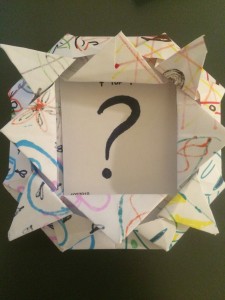The Complaint Origami
The Complaint and The Answer was, although simple to read fast and skim over, a very complicated and crucial text. I wanted to create a piece that showed how simple it is to glance over the complexities of religion and faith and to bring only questioning. In the poems, those asking the questions do not understand why they are not being rewarded for being religious followers, but they do not understand that this is not the object of belief. They do not understand that in trying to be Muslim, they have forgotten to be muslim. They do not understand that in their need to sustain tradition, they have obscured themselves from progression. For this reason, the answer is so complicated to understand. I created an oragami, originally a type of flower, and then turned its edges upwards to create a more complex paper-structure. It does not have a name. Merely, there are many different drawings depicted on the paper to show how difficult it is to grasp at an “answer” when one only views the “answer” as a simple solution. One needs to view the whole work, the whole answer; one needs to flip the edges and turn the solutions inside-out until a true understanding is reached. And understanding comes with change. Therefore, I think that a piece of art that is physical and can be molded truly represents the struggle to attain an “answer”; the closer to the answer one is, the more the answer will looked different. The real answer is always more complex than what one wishes to see. To find the answer, one needs to be open to change. Surrender should come not as an institutionalized concept, but through an intrinsic struggle and motivation towards progress, towards surrender as a muslim.


The Complaint and The Answer was, although simple to read fast and skim over, a very complicated and crucial text. I wanted to create a piece that showed how simple it is to glance over the complexities of religion and faith and to bring only questioning. In the poems, those asking the questions do not understand why they are not being rewarded for being religious followers, but they do not understand that this is not the object of belief. They do not understand that in trying to be Muslim, they have forgotten to be muslim. They do not understand that in their need to sustain tradition, they have obscured themselves from progression. For this reason, the answer is so complicated to understand. I created an oragami, originally a type of flower, and then turned its edges upwards to create a more complex paper-structure. It does not have a name. Merely, there are many different drawings depicted on the paper to show how difficult it is to grasp at an “answer” when one only views the “answer” as a simple solution. One needs to view the whole work, the whole answer; one needs to flip the edges and turn the solutions inside-out until a true understanding is reached. And understanding comes with change. Therefore, I think that a piece of art that is physical and can be molded truly represents the struggle to attain an “answer”; the closer to the answer one is, the more the answer will looked different. The real answer is always more complex than what one wishes to see. To find the answer, one needs to be open to change. Surrender should come not as an institutionalized concept, but through an intrinsic struggle and motivation towards progress, towards surrender as a muslim.
dmuhleisen said this on October 27th, 2015 at 1:31 am
I love this design
Graphic Designer said this on February 11th, 2017 at 7:49 pm
Love it
Web Designer said this on June 28th, 2018 at 4:08 am